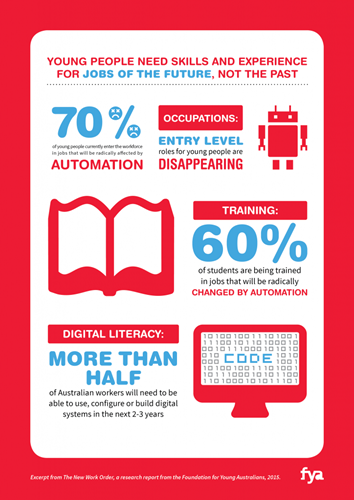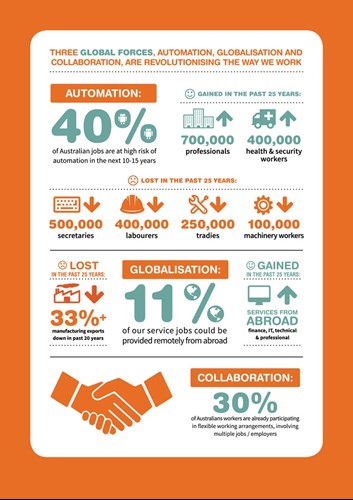-
The predictions are startling: a 15 year-old today should expect to have 17 different jobs in five sectors in his or her working life. Two-thirds of the tertiary study currently being undertaken is towards jobs which soon won’t exist. Three-quarters of all new jobs will require science, maths or technology proficiency.
" Two-thirds of the tertiary study currently being undertaken is towards jobs which soon won’t exist."
Tim Murphy, Former editor-in-chief of the New Zealand HeraldThese are the markers of the ‘future of work’, outlined by Foundation for Young Australians chief executive Jan Owen to a conference in Auckland, New Zealand.
While they are Australian statistics, she said, they would apply almost exactly in all developed countries as globalisation, automation and sophisticated algorithms transform ‘work’.
“The future is closer than you think,” she told the meeting of Labour Party members, unionists and academics. “All these things are not just coming. We are in them.”

GRAPPLING TO ADJUST
It is already taking 4.7 years on average for those finishing higher education to find work in the field for which they’d trained. Globalisation will soon see around 11 per cent of service sector jobs provided remotely from abroad.
New Zealand’s economy, sitting like Australia with relatively low unemployment of 5.9 per cent, is growing thanks to tourism, immigration and a construction boom following the earthquake devastation of Christchurch and a soaraway residential housing market in Auckland.
Policymakers and educators are grappling with how to adjust training and re-set expectations among those who will soon be jobseekers.
Inevitably, if part-time and lower paid work becomes more prevalent, there is a political debate to find ways to ensure people can have sufficient incomes.
Former Clinton administration Labour Secretary Professor Robert Reich and University of London expert Professor Guy Standing urged New Zealand to consider a guaranteed minimum income or universal basic income.
But the political answer will be some time away, if it is ever sellable to an electorate suspicious of universal tax-paid solutions. Experts agree big changes in the education system are needed.
Owens argues developed nations are moving from a 20th-century “knowledge and skills economy” to a 21st-century “innovation economy” where nine of 10 new jobs will involve digital technologies.
Her prescription for change is a national strategy for enterprise skills, in schools from about the age of 12.
“School remains a critical place where young people work together, do things together and problem solve together,” Owens says.
The New Zealand secondary school system, like other markets, has acute shortages of teachers qualified in the STEM (science, technology, engineering and maths) subjects – just at the time proficiency is most needed.
Increasingly, as in the UK, the acronym is being widened to STEAM to include the creative arts and critical thinking (the extra ‘A’ is for arts).
Professor Standing’s view is resources need to be “redistributed” in higher education. “The liberal arts education is seen as a waste but we need people to be critical,” he says.

NO ROOM FOR LOW SKILLED
A leading NZ construction company chief executive, Geoff Hawkins, is blunt.
“One thing certain is there will be less and less opportunity for the lower-skilled,” he says. “Addressing the future of work, we have to address the future of the education system, for those who are currently not succeeding.”
Goran Roos, managing director of Innovation Performance, identifies three types of skills be important in the new age of work: creative problem-solving skills, interpersonal skills and domain-specific skills as taught at universities.
“Jobs in services will disappear at an unprecedented rate,” he says, citing robots to replace baristas and processing power to remove the need for paralegals in law firms.
“The year 2032 is the consensus view where the systems will be smarter and be able to do everything humans are able to do. We will all be hobby workers.”
One area New Zealand has an opportunity in is biotechnology, which is on the NZ Trade and Enterprise list of emerging industries, particularly for medical drugs and equipment. Food, beverages, creative industries like movies and software firms are all seen as homes for future jobs.
Reich stresses the need for world-class technical and vocational education. “We need to disabuse ourselves of the notion everyone needs a College degree,” he says.
New Zealand has a highly deregulated labour market but as a consequence rates high on the OECD rankings of ‘least restrictive’ in terms of employment protection laws.
Those looking to the future worry about the 10 per cent of workers currently in ‘temporary roles’ in accommodation, food, education and training, fishing, forestry and agriculture – many of whom are Maori, Pacific Islanders, female and sole parents.
Gail Pacheco, an economist from Auckland University of Technology, predicts the workplace will require flexibility and collaboration and workers will be increasingly insecure, in lower-paid sectors.
While young people do not have powerful political voices, Owens points to the insecurity felt on their behalf by their parents as a force now prompting action by the education and political systems.
“We do not have the full suite of answers on this,” he says. “We need a national discussion and a really good plan where we can say to young people: This is where we are going.”
Tim Murphy is a journalist and former editor of the NZ Herald.
The views and opinions expressed in this communication are those of the author and may not necessarily state or reflect those of ANZ.
anzcomau:Bluenotes/global-economy,anzcomau:Bluenotes/global-economy/career,anzcomau:Bluenotes/global-economy/labour-market,anzcomau:Bluenotes/global-economy/talent
Educating for a fragmented future in NZ
2016-04-12
/content/dam/anzcomau/bluenotes/images/articles/2016/April/fya-future-of-work-report-thumb.jpg
